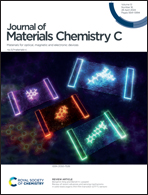A novel selenophene based non-fullerene acceptor for near-infrared organic photodetectors with ultra-low dark current †‡
Abstract
Near-infrared organic photodetectors (OPDs) have great potential in many applications. However, the high dark current of many OPD devices tends to limit their specific detectivity and overall performance. Here we report a novel non-fullerene acceptor (IDSe) based on an alkylated indacenodiselenophene core, with extended light absorption up to 800 nm. When blended with the donor polymer PTQ10, we obtained OPD devices with an exceptionally low dark current density of 1.65 nA cm−2 at −2 V, high responsivity and specific detectivity exceeding 1012 Jones at 790 nm. The superior properties of PTQ10:IDSe devices are related to the higher and more balanced charge carrier mobility compared to the analogous thiophene based blend (PTQ10:IDIC). We also demonstrate large area PTQ10:IDSe based devices by doctor blade in air with a record low dark current of 1.2 × 10−7 A cm−2 under −2 V bias.

- This article is part of the themed collections: Materials for photovoltaic and light emitting devices, 2024 Journal of Materials Chemistry C Most Popular Articles, Journal of Materials Chemistry C Emerging Investigators 2024 and Celebrating our 2024 Prizewinners


 Please wait while we load your content...
Please wait while we load your content...